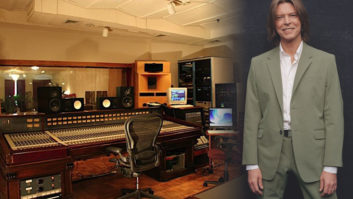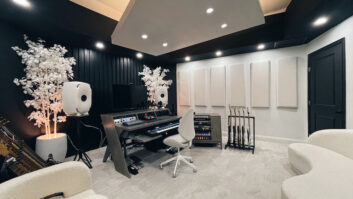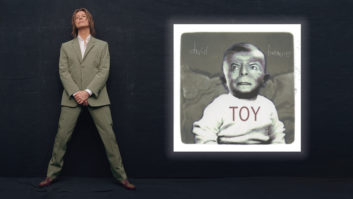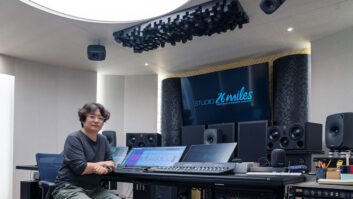After traveling the world for the last five years, the massive museum retrospective, David Bowie Is, is taking its final bow in New York City as it opens today at the Brooklyn Museum. Running through July 15, the exhibition presents more than 500 artifacts from the rock star’s 50-year career, including outrageous costumes, drawings, paintings, tour set dioramas, movie props, favorite books, crucial instruments, rare audio and video, and much more.

The touring exhibition originated at London’s Victoria and Albert Museum; as Victoria Broackes, senior curator, theater and performance at the V&A, explained, “We aimed to create an exhibition that is crucially about inspiration, process and impact. It’s not a chronological review of Bowie’s life, but a thematic exploration, exploring the creative processes of Bowie as a musical innovator, cultural icon and tracing his shifting style of sustained reinvention over five decades.”
As a result, the exhibition largely steers clear of Bowie’s sometimes tumultuous personal life (a rare exception—a small item, labeled “Cocaine Spoon, 1976”), opting instead to delve into the artist’s time in the studio and his work as a performer.
Bowie’s performing life is made readily apparent via the many wild costumes he wore for TV appearances and music videos, but other times it’s presented more subtly, such as an itinerary page from the 1973 Aladdin Sane U.S. tour. Bowie was notoriously fearful of flying, so the production traveled via train as the schedule notes, adding at the bottom, “After Denver we cannot continue by rail as whatever trains there are don’t run on the days wee (sic) need them. We will therefore go by Caravan-truck, or covered wagons or Pegasus-drawn chariots.”

Nonetheless, Bowie’s studio days are also intriguingly represented in various ways, most often via choice instruments. Visitors can spot his Dubreq Stylophone—a miniature analog synth with a metal keyboard played with a stylus; introduced to the instrument by T. Rex’s Marc Bolan, Bowie used it on his breakthrough hit, “Space Oddity.”
Later on, the Koto played on “Moss Garden” from Heroes sits next to a 1974 EMS AKS Synthi synthesizer used in the recording of Low, “Heroes” and Lodger. Its original owner, Brian Eno, gifted it to Bowie in 1999 with a note: “Look after it. Patch it up in strange ways—it’s surprising that it can still make noises that nothing else can make.” Bowie soon put it to work on 2002’s Heathen album.

Elsewhere, there’s an invoice from producer Gus Dudgeon for the string session behind “Space Oddity;” 85 handwritten lyric sheets with plenty of notes and crossed-out lines that didn’t make the final cut; and some video commentary from legendary producer/collaborator Tony Visconti—who, it should be noted, will give a lecture at the museum on April 5 at 7PM; tickets start at $25.

As it has throughout the exhibition’s tour, Sennheiser and its audio gear play a vital role, with the company’s headphone-based GuidePORT systems used to immerse visitors in music and interviews, all synchronized to specific exhibits, video screens and more. For the New York stop, said Stefanie Reichert, director of Retail Trade Marketing/Lifestyle Business Development for Sennheiser USA, the GuidePORT systems’ headphones were upgraded, allowing visitors to hear the show through premium consumer HD-1 headphones.
Separate to the GuidePORT system, Sennheiser also created the highpoint of the exhibition—a large, immersive AMBEO 9.1 audio space where visitors are surrounded on three sides by giant video screens presenting concert footage from different eras of Bowie’s career.

The Brooklyn Museum edition features an expanded AMBEO experience, according to Robert Genereux, research and innovation, Sennheiser, who designed and oversaw installation of the exhibition’s audio technology at every museum: “For New York, we said, ‘OK, we want to make it bigger and better,’ so instead of three songs as we did for everywhere else, it’s six songs that are mixed with the AMBEO technology. Because the original recordings were not 3D, Gregor Zielinski took the original mono and stereo files and made this magic, creating an immersive experience using studio processing for the upmix. Now you feel immersed, like in the crowd, and that’s what we want to have people experience.”
While each museum installation required Genereux to be onsite for three weeks before opening, “By the time one venue opens, I’m already at work on the next one,” he said. “The zoning is custom-made for each museum, because every location has a new design. The system can affect the exhibition, too, because it can do things that no other system can do, so this influenced how they layout exhibits. The design takes place before we get there, because it has to be integrated into the drawings and the design of the museum, [taking into consideration] AV integration, power sources and everything you can think of. I’m not the only one; others are doing their work at the same time, like lighting and video players, and everyone is moving forward together.”

When David Bowie Is first debuted at the V&A in London, its namesake was still alive (he never visited the exhibition, though we’re told unofficially he nearly saw it at Chicago’s Museum of Contemporary Art in September, 2014). As it happens, since the tour began in 2013, GuidePORT has reached its end, too, as some of the components used as part of the technology have since been discontinued by Sennheiser’s suppliers. Will GuidePORT have a successor? Sennheiser officials have no answer, but the systems remain in use on other rock-oriented V&A touring exhibitions, including Pink Floyd: Their Mortal Remains and You Say You Want a Revolution? Records and Rebels 1966-1970; and Sennheiser has been tapped to be part of another one currently in development. For now, Genereux remains sanguine about the turn of events: “Our goal is not necessarily to sell GuidePORT, but to promote the expertise of Sennheiser and our 3D audio work like AMBEO; it shows our expertise.”
David Bowie Is • https://www.brooklynmuseum.org/exhibitions/davidbowieis
Sennheiser USA • www.sennheiser.com







